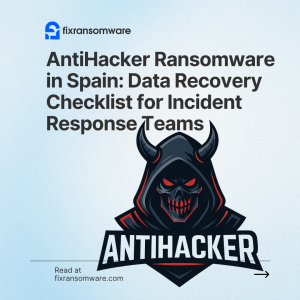When a company faces AntiHacker ransomware in Spain, chaos often starts in minutes. Shared folders stop working, key applications crash, and ransom notes appear on critical servers. Files may even use a new extension such as .antihacker, which makes staff think everything is lost. However, incident response teams still have a real chance to restore systems safely if they follow a clear and disciplined data recovery checklist.
This guide explains a practical step-by-step approach so your team can handle AntiHacker ransomware in Spain without panic and without rushing into risky decisions.
Understand the Impact of AntiHacker Ransomware Before Taking Action
First, the incident response team needs a quick but structured picture of the situation. Instead of touching servers immediately, map the impact:
- Identify which servers hold encrypted data: file servers, application servers, domain controllers, and databases.
- List which storage platforms suffer from encryption: local disks, SAN, NAS, and backup repositories.
- Connect this map to business processes: billing, payroll, logistics, and customer support.
As a result, you get a simple impact overview: where the infection lives, what AntiHacker ransomware in Spain already broke, and which services must come back online first. This overview guides every recovery decision that follows.
Immediate Containment Checklist
Next, focus on containment. If the malware still runs, any recovery effort becomes unstable.
- Isolate infected systems
- Remove compromised servers and workstations from LAN, Wi-Fi, and VPN.
- If remote users may carry the ransomware, temporarily disable or heavily restrict VPN access.
- Stop active encryption processes
- Use process lists, services, scheduled tasks, and startup entries to spot suspicious binaries.
- Terminate clearly malicious processes; then prevent them from starting again.
- Preserve encrypted data
- Keep the encrypted files on disk. Do not delete them “to clean up”.
- These files form the raw material for any serious AntiHacker ransomware data recovery attempt.
- Collect forensic evidence
- Save ransom notes, firewall and VPN logs, endpoint security alerts, and suspicious emails.
- This evidence supports internal reporting and aligns with public guidance such as CISA StopRansomware.
By the end of this stage, the attack stops spreading and the team keeps both the data and the evidence intact.
Map Damage and Backups for AntiHacker Ransomware in Spain
After containment, shift the focus from “firefighting” to structured analysis.
First, classify impacted systems by business priority:
- Tier 1: ERP, finance, CRM, production databases, and core file servers.
- Tier 2: reporting servers, secondary apps, and collaboration tools.
- Tier 3: lab VMs, test environments, and legacy systems.
Second, evaluate backup options honestly:
- Check for offline or immutable backups that AntiHacker could not modify.
- Review off-site backups such as cloud snapshots or tape archives.
- Perform small restore tests in an isolated environment before planning a large-scale recovery.
Third, validate that you truly face AntiHacker ransomware in Spain:
- Compare ransom note wording, contact details, and file extensions with known AntiHacker patterns.
- Use this identification to avoid generic “one-size-fits-all” tools that often damage data.
Finally, reject random decryptors from untrusted sources. Many of them corrupt databases, VMDK images, and large files, which makes professional recovery far more difficult.
Why Paying or Rebuilding Everything Rarely Solves the Problem
At this point, management usually suggests two extreme options: “Let’s just pay” or “Let’s wipe and rebuild everything.” Both ideas sound simple, yet they create new risks.
Paying the ransom:
- Hackers do not guarantee a working decryption key.
- Even when a key arrives, decryption can fail, stop halfway, or corrupt a portion of your data.
- The organisation may become a known “paying victim”, which attracts further attacks.
Rebuilding every system from scratch:
- This approach destroys evidence and removes the possibility of targeted data recovery.
- Any data that never reached a clean backup location may disappear forever.
Therefore, treat these options as last resorts, not as your default strategy for AntiHacker ransomware in Spain.
Safe Data Recovery Workflow for Incident Response Teams
Instead of gambling, apply a controlled recovery workflow.
- Create verified copies of encrypted data
- Copy encrypted files, VM images, and databases to secure storage.
- Keep at least one untouched snapshot so you can always roll back tests.
- Request a sample-based technical assessment
- Provide a limited set of encrypted files and, when possible, the original clean versions.
- Specialists analyse structure and encryption patterns to determine realistic recovery paths.
- Test recovery methods in an isolated lab
- Build a dedicated test environment that mirrors key parts of production.
- Run decryption or low-level repair only on copies, then compare results with known-good data.
- Restore by business priority
- Bring Tier 1 systems (finance, ERP, production) online first.
- Then recover Tier 2 and Tier 3 systems as the situation stabilises.
- Harden the environment before full go-live
- Patch public-facing services, close unnecessary ports, tighten remote access, and rotate passwords and keys.
- Redesign the backup strategy with offline or immutable layers plus regular restore drills.
A specialised team like FixRansomware focuses on complex server, NAS, and database cases, including AntiHacker. You can submit small encrypted samples (under 1 MB) safely via app.fixransomware.com, then share larger datasets through secure cloud storage links for deeper analysis.
Handled with this kind of structure, an incident involving AntiHacker ransomware in Spain turns from a full-blown disaster into a controlled recovery project with clear priorities and realistic expectations.


